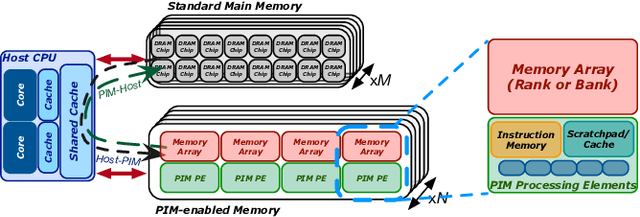Sylvan Brocard
An Experimental Evaluation of Machine Learning Training on a Real Processing-in-Memory System
Jul 16, 2022
Abstract:Training machine learning (ML) algorithms is a computationally intensive process, which is frequently memory-bound due to repeatedly accessing large training datasets. As a result, processor-centric systems (e.g., CPU, GPU) suffer from costly data movement between memory units and processing units, which consumes large amounts of energy and execution cycles. Memory-centric computing systems, i.e., with processing-in-memory (PIM) capabilities, can alleviate this data movement bottleneck. Our goal is to understand the potential of modern general-purpose PIM architectures to accelerate ML training. To do so, we (1) implement several representative classic ML algorithms (namely, linear regression, logistic regression, decision tree, K-Means clustering) on a real-world general-purpose PIM architecture, (2) rigorously evaluate and characterize them in terms of accuracy, performance and scaling, and (3) compare to their counterpart implementations on CPU and GPU. Our evaluation on a real memory-centric computing system with more than 2500 PIM cores shows that general-purpose PIM architectures can greatly accelerate memory-bound ML workloads, when the necessary operations and datatypes are natively supported by PIM hardware. For example, our PIM implementation of decision tree is $27\times$ faster than a state-of-the-art CPU version on an 8-core Intel Xeon, and $1.34\times$ faster than a state-of-the-art GPU version on an NVIDIA A100. Our K-Means clustering on PIM is $2.8\times$ and $3.2\times$ than state-of-the-art CPU and GPU versions, respectively. To our knowledge, our work is the first one to evaluate ML training on a real-world PIM architecture. We conclude with key observations, takeaways, and recommendations that can inspire users of ML workloads, programmers of PIM architectures, and hardware designers & architects of future memory-centric computing systems.
Machine Learning Training on a Real Processing-in-Memory System
Jun 13, 2022
Abstract:Training machine learning algorithms is a computationally intensive process, which is frequently memory-bound due to repeatedly accessing large training datasets. As a result, processor-centric systems (e.g., CPU, GPU) suffer from costly data movement between memory units and processing units, which consumes large amounts of energy and execution cycles. Memory-centric computing systems, i.e., computing systems with processing-in-memory (PIM) capabilities, can alleviate this data movement bottleneck. Our goal is to understand the potential of modern general-purpose PIM architectures to accelerate machine learning training. To do so, we (1) implement several representative classic machine learning algorithms (namely, linear regression, logistic regression, decision tree, K-means clustering) on a real-world general-purpose PIM architecture, (2) characterize them in terms of accuracy, performance and scaling, and (3) compare to their counterpart implementations on CPU and GPU. Our experimental evaluation on a memory-centric computing system with more than 2500 PIM cores shows that general-purpose PIM architectures can greatly accelerate memory-bound machine learning workloads, when the necessary operations and datatypes are natively supported by PIM hardware. To our knowledge, our work is the first one to evaluate training of machine learning algorithms on a real-world general-purpose PIM architecture.
 Add to Chrome
Add to Chrome Add to Firefox
Add to Firefox Add to Edge
Add to Edge